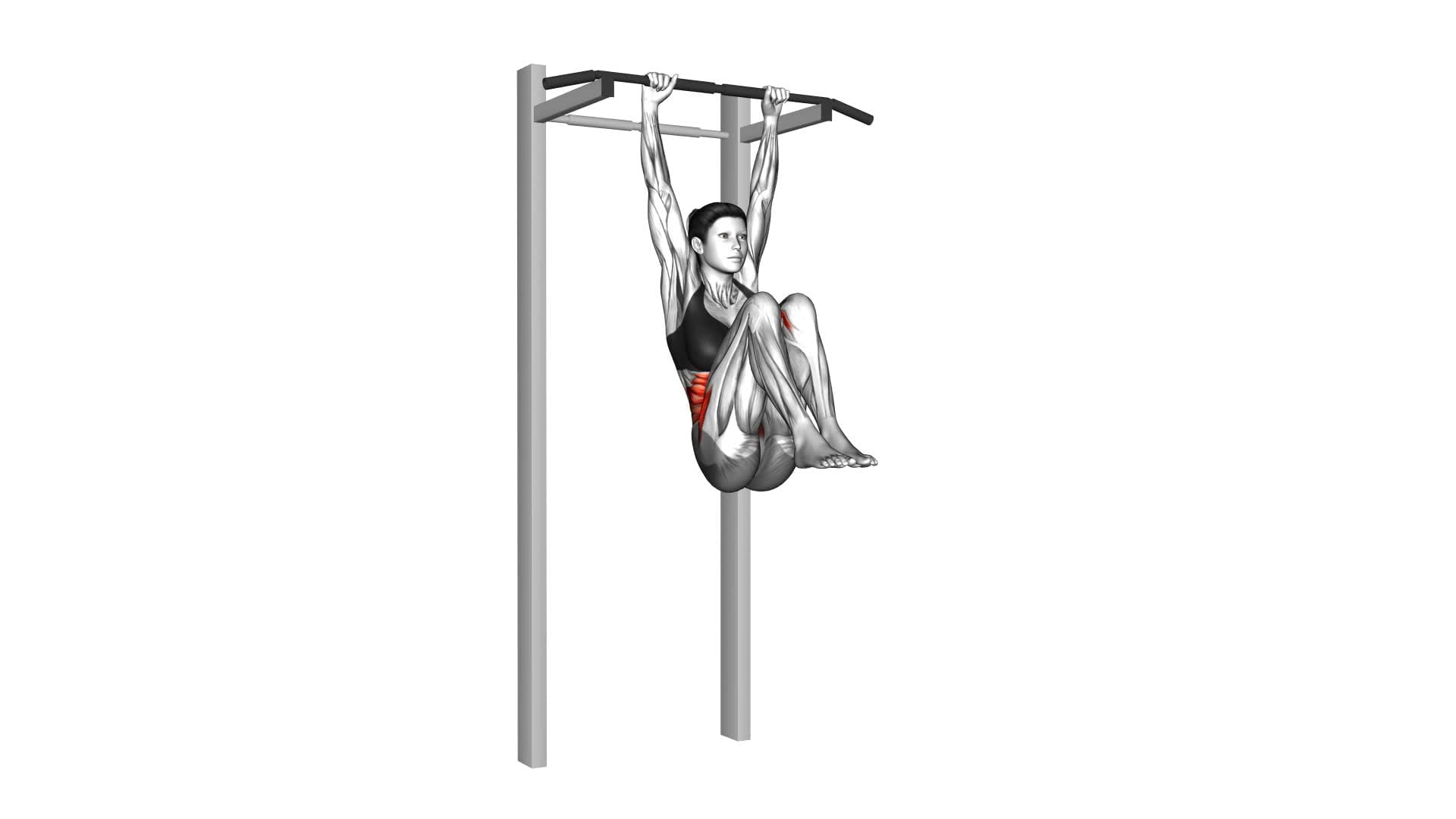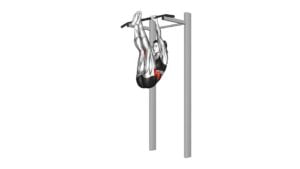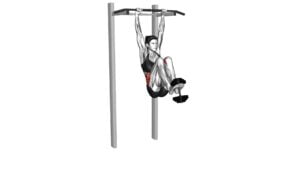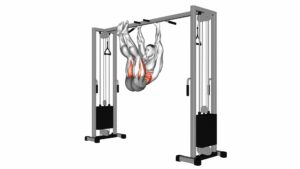Hanging Leg Hip Raise (female) – Video Exercise Guide & Tips

Are you looking to strengthen your core and hip muscles? Look no further than the hanging leg hip raise.
Watch This Exercise Video
This exercise targets your lower abs, obliques, and hip flexors, helping to improve stability and overall strength.
In this video exercise guide, we'll show you the proper form and technique, as well as common mistakes to avoid.
Plus, we'll provide variations and progressions to challenge yourself.
Get ready to take your core workout to the next level with the hanging leg hip raise.
Key Takeaways
- Targets lower abs, obliques, and hip flexors
- Improves stability and overall strength
- Enhances core strength and hip flexibility
- Activates rectus abdominis, obliques, and transverse abdominis
Benefits of Hanging Leg Hip Raise
Improve your core strength and hip flexibility with the Hanging Leg Hip Raise exercise. This exercise primarily targets your abdominal muscles, specifically the rectus abdominis, as well as your hip flexors. By engaging these muscles, you can enhance your overall core strength and stability.
The Hanging Leg Hip Raise requires you to hang from a bar or straps with your arms extended and your legs straight. From this position, you'll raise your legs by flexing your hips and bending your knees, bringing your thighs up towards your chest. As you raise your legs, focus on contracting your abs and engaging your hip flexors to lift your legs as high as possible.
This exercise activates the muscles in your core, including your rectus abdominis, obliques, and transverse abdominis. It also strengthens your hip flexors, which play a crucial role in movements such as walking, running, and even sitting.
Equipment Needed for Hanging Leg Hip Raise
To perform the Hanging Leg Hip Raise exercise, you'll need a bar or straps that can support your weight. Here is a list of equipment needed for Hanging Leg Hip Raise:
- Pull-up Bar: A sturdy pull-up bar is essential for this exercise. Make sure it can hold your body weight without bending or breaking.
- Straps: If you don't have a pull-up bar, you can use hanging straps instead. These straps should be strong and securely attached to a stable point.
- Gym Rings: Another option is to use gym rings, which provide a versatile and adjustable setup for the exercise. Make sure the rings are properly secured and can support your weight.
- Weight Belt: For added resistance, you can wear a weight belt during the Hanging Leg Hip Raise. This will challenge your core muscles even more.
Remember, the equipment you choose will depend on your personal preference and what's available to you. It's important to ensure that whatever equipment you use is safe, stable, and can support your weight.
Now that you know the equipment needed, you can confidently perform the Hanging Leg Hip Raise and explore different variations to challenge your core muscles.
Proper Form and Technique for Hanging Leg Hip Raise
To perform the Hanging Leg Hip Raise exercise with proper form and technique, focus on engaging your core and using controlled movements throughout the exercise. This exercise primarily targets your lower abdominals, hip flexors, and glutes.
Start by hanging from a pull-up bar with your arms fully extended. Keep your legs straight and together, and maintain a slight bend in your knees to avoid strain on your lower back. Take a deep breath in and exhale as you lift your legs towards the ceiling, using your core muscles to initiate the movement.
As you raise your legs, focus on keeping your lower back flat against the floor and avoid excessive swinging. This will ensure proper muscle activation and prevent strain on your lower back.
At the top of the movement, pause for a moment and squeeze your glutes. This will help to further engage your hip muscles.
Inhale as you slowly lower your legs back to the starting position, maintaining control throughout the movement. Repeat for the desired number of repetitions.
Remember to use proper breathing techniques throughout the exercise. Exhale during the exertion phase and inhale during the relaxation phase. This will help you maintain stability and control, and maximize the benefits of the exercise.
Common Mistakes to Avoid During Hanging Leg Hip Raise
To ensure proper form during the hanging leg hip raise, it's important to keep a few tips in mind.
First, maintain a controlled movement and avoid swinging your legs.
Second, focus on your breathing technique, exhaling as you lift your legs and inhaling as you lower them.
Lastly, be aware of common mistakes such as using momentum instead of core strength and not fully engaging your abdominal muscles.
Proper Form Tips
One mistake to avoid during the Hanging Leg Hip Raise is arching your back. Maintaining proper form is crucial to effectively target your abdominal muscles and avoid injury.
Here are some common mistakes to watch out for and tips to ensure proper form:
- Engage your core: Before starting the exercise, activate your abdominal muscles to provide stability and support during the movement.
- Maintain a neutral spine: Avoid arching your back by keeping your spine in a straight line from your head to your tailbone.
- Control your leg movement: Use your abdominal muscles to lift your legs, ensuring that the movement is slow and controlled.
- Avoid swinging: Prevent momentum by using your core strength to lift your legs, rather than relying on swinging movements.
By following these form tips, you'll maximize the benefits of the Hanging Leg Hip Raise and reduce the risk of injury.
Now, let's move on to the importance of proper breathing technique.
Breathing Technique Importance
Maintain proper breathing technique during the Hanging Leg Hip Raise to optimize your workout and avoid common mistakes.
Proper breathing techniques help to engage your core muscles and enhance the effectiveness of this exercise. As you lift your legs, exhale and contract your abdominal muscles, focusing on the upward movement. This exhalation helps to create tension and stability in your core, allowing for better control and balance.
Avoid holding your breath or breathing too shallowly, as it can lead to improper form and decreased muscle activation. Remember to inhale as you lower your legs back down, allowing for a smooth and controlled movement.
Common Mistakes Explained
To avoid common mistakes during the Hanging Leg Hip Raise, make sure you're engaging your core and maintaining proper form throughout the exercise. Here are some common mistakes to watch out for and how to avoid them:
- Improper breathing: Many people forget to breathe properly during this exercise. Remember to exhale as you lift your legs and inhale as you lower them. Proper breathing helps with muscle engagement and stability.
- Lack of muscle engagement: It's important to engage your core and activate your hip flexors throughout the movement. This will ensure that you're targeting the right muscles and getting the most out of the exercise.
- Swinging your legs: Avoid using momentum to swing your legs up and down. Instead, focus on controlled movements and use your abdominal muscles to lift your legs.
- Arching your back: Keep your spine neutral and avoid arching your back excessively. This will help maintain proper form and prevent any strain or injury.
By avoiding these common mistakes and focusing on proper breathing and muscle engagement, you can maximize the effectiveness of the Hanging Leg Hip Raise.
Now, let's move on to the next section to learn about variations and progressions for this exercise.
Variations and Progressions for Hanging Leg Hip Raise
To increase the difficulty of the Hanging Leg Hip Raise, you can try incorporating variations and progressions into your workout routine. These variations and progressions will challenge your muscles in new ways and help you continue to make progress in your fitness journey.
One variation you can try is the Hanging Knee Raise. Instead of extending your legs straight out in front of you, you can bend your knees and bring them up towards your chest. This variation targets your lower abs and can be a great way to build strength in that area.
Another variation is the Hanging Oblique Raise. To perform this exercise, you can twist your legs to the side as you lift them up towards your chest. This variation specifically targets your oblique muscles, helping to sculpt and define your waistline.
To progress further, you can incorporate ankle weights or a weighted belt into your hanging leg hip raise routine. Adding extra resistance will increase the challenge and help you build even more strength in your core and hip muscles.
Remember to always maintain proper form and listen to your body. Start with the variations that feel comfortable to you and gradually increase the difficulty as you get stronger.
Have fun and enjoy the process of challenging yourself and achieving your fitness goals.
Tips for Getting the Most Out of Hanging Leg Hip Raise
To get the most out of the hanging leg hip raise, it's important to focus on proper form techniques. Keep your core engaged and avoid swinging or using momentum to lift your legs.
Additionally, pay attention to muscle activation by squeezing your glutes and engaging your lower abdominal muscles throughout the exercise.
Proper Form Techniques
Get the most out of the Hanging Leg Hip Raise by focusing on proper form techniques. Follow these tips to ensure you're performing the exercise correctly and effectively:
- Maintain proper breathing techniques: Inhale as you lower your legs and exhale as you raise them. This helps engage your core muscles and stabilize your body.
- Keep your core engaged: Throughout the exercise, focus on tightening your abdominal muscles. This will help protect your lower back and maximize muscle activation.
- Control the movement: Avoid using momentum to swing your legs up. Instead, use your core strength to lift your legs in a slow and controlled manner.
- Maintain proper body alignment: Keep your shoulders pulled back and down, and your back straight. This helps target the correct muscles and prevents strain on your neck and shoulders.
By following these proper form techniques, you'll maximize muscle activation and get the most out of your Hanging Leg Hip Raise.
Now, let's dive into some muscle activation tips.
Muscle Activation Tips
By engaging your core and controlling the movement, you can optimize the muscle activation during the Hanging Leg Hip Raise.
To ensure proper muscle engagement, focus on the following activation techniques. Firstly, maintain a neutral spine throughout the exercise by keeping your back straight and avoiding excessive arching or rounding. This will help activate the muscles in your core and lower back.
Secondly, concentrate on contracting your abdominal muscles as you lift your legs, rather than relying solely on momentum. This will maximize the activation of your rectus abdominis and obliques.
Lastly, control the descent of your legs to engage your hip flexors and lower abdominal muscles.
Frequently Asked Questions
How Many Sets and Repetitions Should I Do for the Hanging Leg Hip Raise Exercise?
To progress in the hanging leg hip raise exercise, start with 3 sets of 8-10 repetitions.
As you get stronger, gradually increase the number of sets and repetitions.
Avoid common mistakes like swinging or using momentum to lift your legs.
Focus on engaging your core and using controlled movements.
Remember to breathe throughout the exercise.
With consistency and proper form, you'll build strength and stability in your hip muscles.
Can I Do Hanging Leg Hip Raise if I Have Lower Back Pain?
If you're experiencing lower back pain, you may need to modify the hanging leg hip raise exercise. To prevent further strain, try bending your knees instead of keeping your legs straight. This will reduce the pressure on your lower back.
Alternatively, you can switch to other exercises that target the same muscles, such as reverse crunches or seated knee tucks.
Remember to consult with a healthcare professional before making any changes to your workout routine.
Is It Necessary to Perform Hanging Leg Hip Raises With a Specific Tempo or Speed?
When performing hanging leg hip raises, it's important to consider the tempo or speed at which you perform the exercise. Different tempo variations can provide various benefits.
For instance, slower tempos can increase time under tension and help build muscle endurance.
On the other hand, faster tempos can enhance explosive power and speed.
Experimenting with different speeds can help you target different muscle fibers and achieve your desired training goals.
Can I Substitute Hanging Leg Hip Raises With Another Exercise That Targets the Same Muscles?
Yes, you can substitute hanging leg hip raises with alternative exercises that target the same muscles.
However, it's important to note that hanging leg hip raises have unique benefits.
They specifically engage your hip flexors, lower abs, and obliques, helping to strengthen and tone those areas.
While other exercises like hanging leg raises or reverse crunches may target similar muscles, they may not provide the same level of activation and range of motion as hanging leg hip raises.
Are There Any Modifications or Alternatives for People Who Cannot Hang From a Bar?
If you can't hang from a bar, don't worry! There are alternative exercises and modifications for the hanging leg hip raise.
You can try seated leg lifts or lying leg raises to target the same muscles.
Another option is using a captain's chair or dip station to perform knee or leg raises.
Start with easier progressions and gradually work your way up to the hanging leg hip raise when you're ready.
Conclusion
In conclusion, the hanging leg hip raise is a highly effective exercise that targets the core and hip muscles. By using proper form and technique, you can maximize the benefits of this exercise and avoid common mistakes.
Additionally, incorporating variations and progressions can challenge your muscles even further. Remember to use the right equipment and follow the tips provided to get the most out of your hanging leg hip raise workouts.

Author
Years ago, the spark of my life’s passion ignited in my mind the moment I stepped into the local gym for the first time. The inaugural bead of perspiration, the initial endeavor, the very first surge of endorphins, and a sense of pride that washed over me post-workout marked the beginning of my deep-seated interest in strength sports, fitness, and sports nutrition. This very curiosity blossomed rapidly into a profound fascination, propelling me to earn a Master’s degree in Physical Education from the Academy of Physical Education in Krakow, followed by a Sports Manager diploma from the Jagiellonian University. My journey of growth led me to gain more specialized qualifications, such as being a certified personal trainer with a focus on sports dietetics, a lifeguard, and an instructor for wellness and corrective gymnastics. Theoretical knowledge paired seamlessly with practical experience, reinforcing my belief that the transformation of individuals under my guidance was also a reflection of my personal growth. This belief holds true even today. Each day, I strive to push the boundaries and explore new realms. These realms gently elevate me to greater heights. The unique combination of passion for my field and the continuous quest for growth fuels my drive to break new ground.







